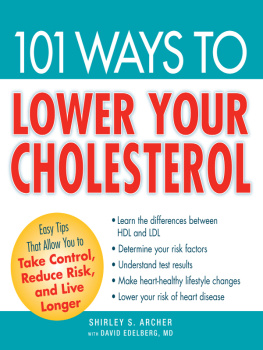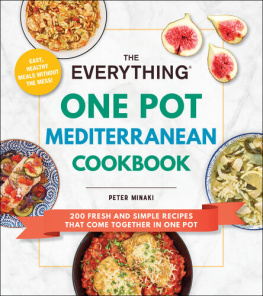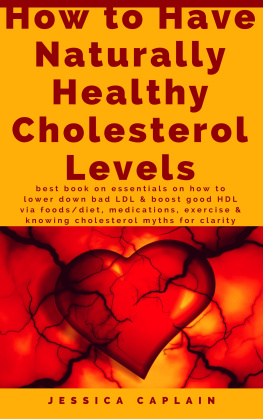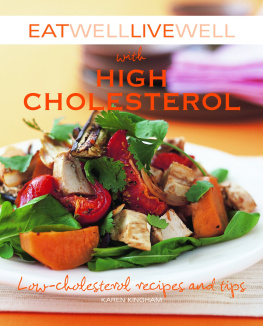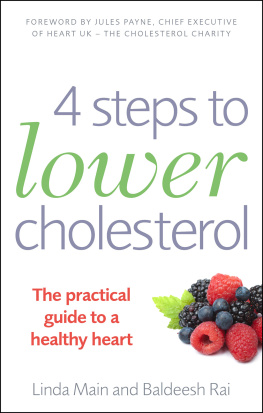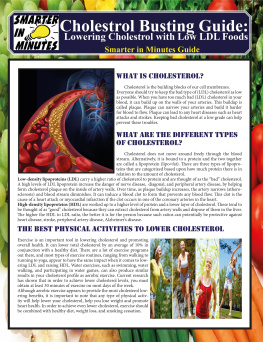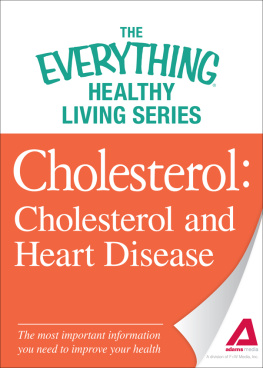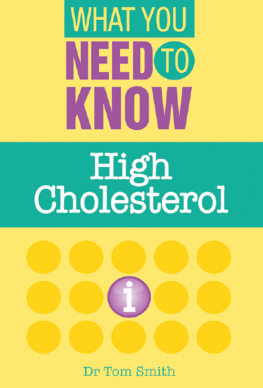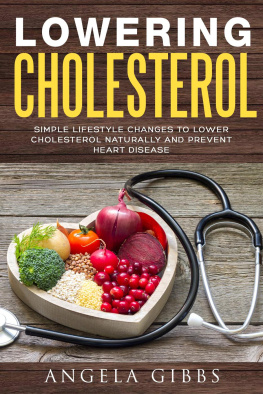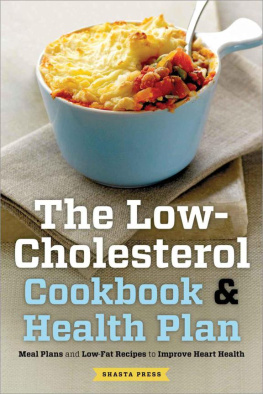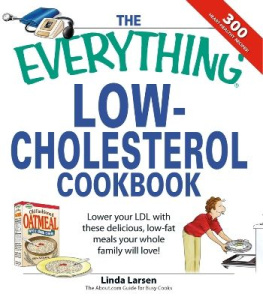
101 WAYS TO
LOWER YOUR
CHOLESTEROL

Easy Tips That Allow You to
Take Control, Reduce Risk, and Live Longer

SHIRLEY S. ARCHER WITH DAVID EDELBERG, MD

Copyright 2010 by F+W Media, Inc.
All rights reserved.
This book, or parts thereof, may not be reproduced in any form without permission from the publisher; exceptions are made for brief excerpts used in published reviews.
Contains material adapted and abridged from The EverythingLow Cholesterol Book by Shirley Archer, copyright 2004 by F+W Media, Inc.,
ISBN 10: 1-59337-146-2, ISBN 13: 978-1-59337-146-3.
eISBN: 978-1-6055-0129-1
Published by
Adams Media, a division of F+W Media, Inc.
57 Littlefield Street, Avon, MA 02322. U.S.A.
www.adamsmedia.com
ISBN 10: 1-60550-129-8
ISBN 13: 978-1-60550-129-1
eISBN: 978-1-44051-307-7
Printed in the United States of America.
10 9 8 7 6 5 4 3 2 1
Library of Congress Cataloging-in-Publication Data
is available from the publisher.
This publication is designed to provide accurate and authoritative information with regard to the subject matter covered. It is sold with the understanding that the publisher is not engaged in rendering legal, accounting, or other professional advice. If legal advice or other expert assistance is required, the services of a competent professional person should be sought.
From a Declaration of Principles jointly adopted by a Committee of the
American Bar Association and a Committee of Publishers and Associations
Many of the designations used by manufacturers and sellers to distinguish their product are claimed as trademarks. Where those designations appear in this book and Adams Media was aware of a trademark claim, the designations have been printed with initial capital letters.
This book is available at quantity discounts for bulk purchases.
For information, please call 1-800-289-0963.
Contents
INTRODUCTION
The Big Picture of Cholesterol Health
Cholesterol may not seem like the most exciting topic in the world, but given the huge role it plays in your health, cholesterol is actually very important. Youve probably heard about it in the news, seen it on nutrition labels, or even had a discussion about it during a visit to your doctors office. While cholesterol is a naturally occurring substance that appears in each cell in the body, it is also something that can get out of control if its not properly monitored and managed. All kinds of things contribute to your cholesterol status, from what you eat and your level of physical activity to your family history and the condition of your overall health. This means that it often takes a multipronged approach to keep your cholesterol on track.
Youve doubtless heard all sorts of scary statistics about the numbers of deaths due to heart attacks, strokes, and other heart-disease-related events. Youve probably also heard that incidence of obesity and related conditions such as diabetes are on the rise in this country. While those statistics and numbers are factual, it doesnt mean that you, too, will become a statistic. Thats why youve picked up this book, right? Youve already begun to take the reins on your health in order to ensure a long, healthful future for yourself. This, in itself, is a big part of the battle.
Now that you have this book in hand, its time to start delving into the deeper issues. In the following chapters youll first learn what cholesterol is and how it works, and then youll go on to find out how you can monitor and manage it with tests and treatments. Youll also read about changes you can make in your diet and lifestyle to keep yourself feeling good, inside and out. Part IV offers delicious and nutritious recipes that you can work into your meal plan, and Part V is all about weight management and exercise. In short, youve got all your bases covered. Just follow the advice in this book, and youll be well on your way to a happier, healthier life.
PART I
WHAT IS CHOLESTEROL?
CHAPTER 1
The Basic Breakdown
Cholesterol is a waxy lipid, or fatlike substance, that is a necessary and natural part of each cell in the body. It helps to maintain the structure of the walls of cell membranes, and it also works to keep our brains healthy. The liver manufactures cholesterol and uses it as raw material in the creation of important hormones and digestive enzymes. In addition to being manufactured in the body, cholesterol gets into the bloodstream through the food that you eat. In particular, if you eat too much saturated fat, the result is an elevated blood cholesterol level. The big picture, however, is not as simple as that. Many other factors play a role in the composition of cholesterol levels.
1. Learn How the System Works
The major players in the cholesterol picture are the liver and the blood fats.
To support bodily functions, the liver synthesizes cholesterol, lipoproteins, triglycerides, and phospholipids. The liver manufactures both low-density and high-density lipoprotein (LDL and HDL) that are needed to transport cholesterol into the bloodstream for use in other tissues. The liver also collects them back from the bloodstream to keep blood cholesterol from getting too high. Blood fats are the building blocks the liver uses to produce cholesterol.
The body uses LDL cholesterol to build cell membranes, create essential hormones, and form digestive enzymes. This LDL cholesterol needs to be transported throughout the body. However, cholesterol is fatty and blood is watery; oil and water do not mix. This dilemma is resolved in the liver, where cholesterol is combined and coated with proteins to create lipoproteins. The protein coating enables fat to travel in the bloodstream.
To simplify how this process works, imagine a pickup and delivery service to and from the liver, which is the cholesterol manufacturing plant. Imagine that the lipoproteins are like delivery trucks that carry packages of cholesterol in the bloodstream. The function of the HDL delivery trucks is to pick up excess LDL cholesterol packages from the bloodstream and return them to the liver for repackaging as needed.
Another type of lipoprotein, VLDL, or very low-density lipoprotein, acts as the delivery truck that transports the LDL cholesterol throughout the body and delivers it to all the cells. The cell receptors are the dropoff stops where the LDL deliveries are made. The VLDL delivery truck also carries blood fats called triglycerides. These fats are available for immediate use by the body as energy, or for storage in fat cells for later use.
2. Dont Overload the System
Unfortunately, modern living conditions strain the system. By eating too much and moving too little, people make it all too easy for this delicately balanced delivery, pickup, and storage system to break down. The efficiency begins to fail when more LDL packages are transported in the bloodstream than are needed by the bodys tissues. This excess LDL cholesterol continues to circulate in the bloodstream, increasing fat levels in the bloodstream and contributing to congestion on the roadways or arteries.
Next page
